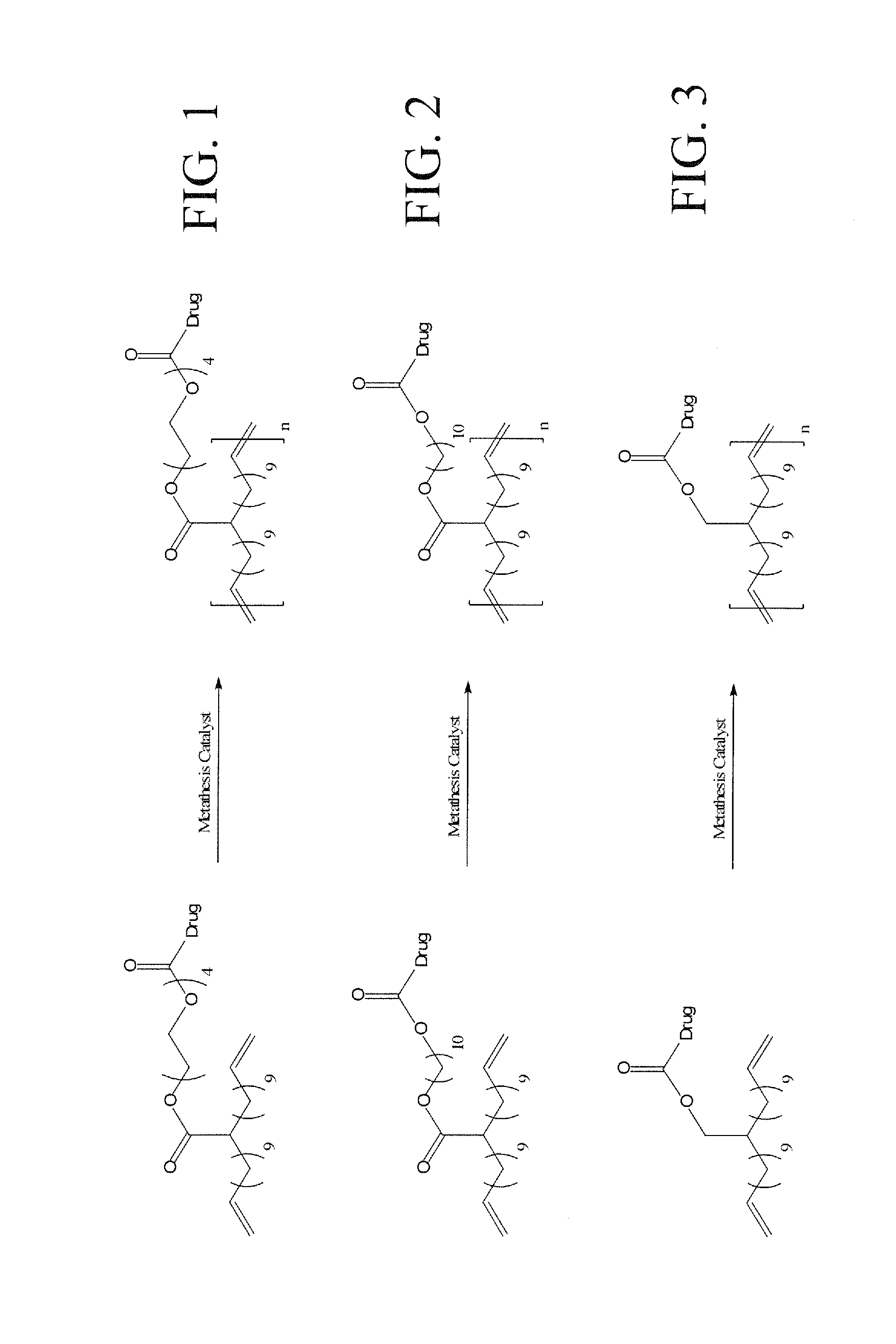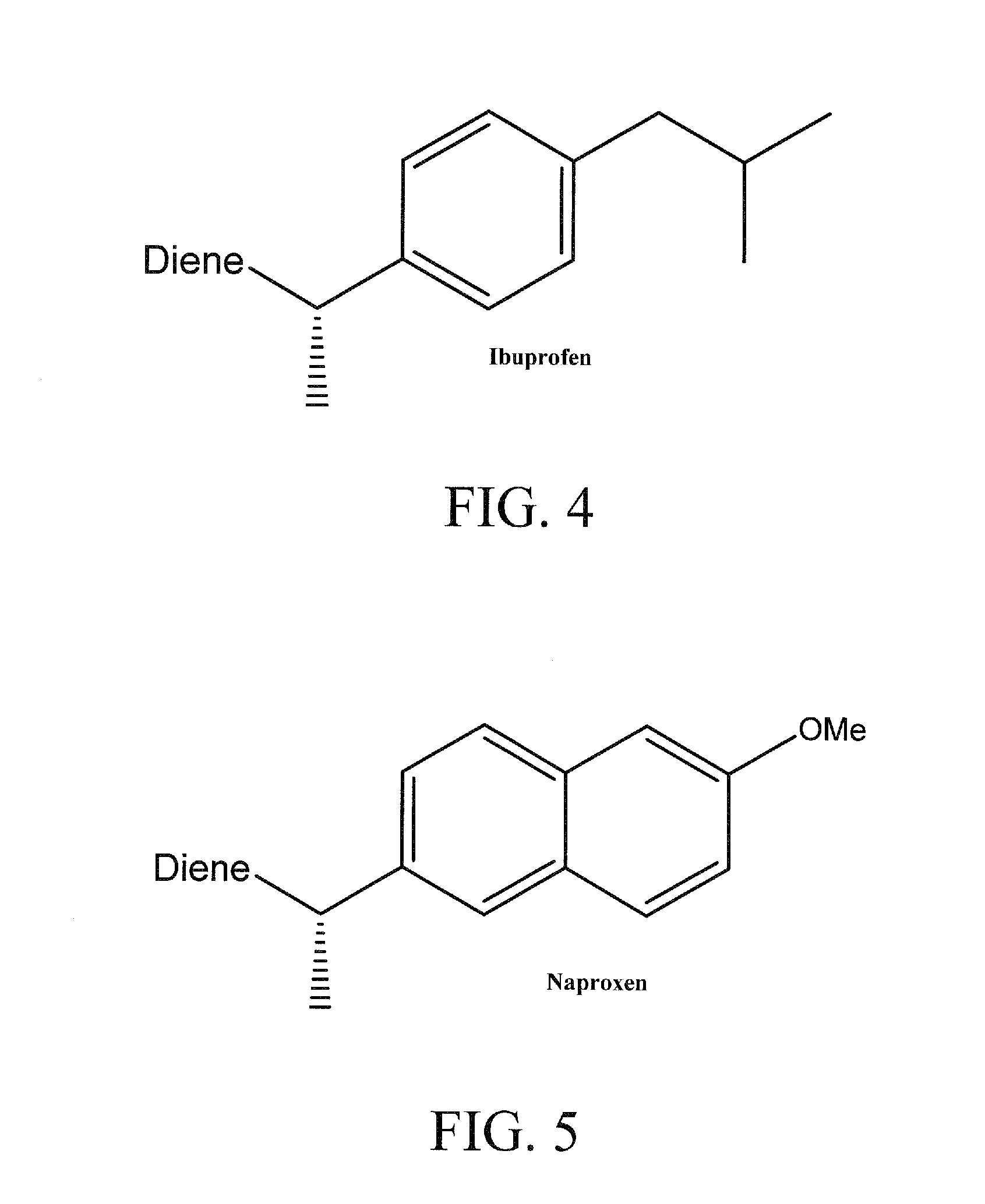Polyethylene Based Bioactive Agents
a bioactive agent and polyethylene technology, applied in the field of polyethylene based bioactive agents, can solve the problems of large application range of this methodology, loss of product during isolation and purification, use of additional, etc., and achieve the effect of easy elimination from the body
Inactive Publication Date: 2010-10-07
UNIV OF FLORIDA RES FOUNDATION INC
View PDF9 Cites 2 Cited by
- Summary
- Abstract
- Description
- Claims
- Application Information
AI Technical Summary
Benefits of technology
[0016]By using a diene acid precursor, such as 3,3 acid, 6,6 acid, 9,9 acid, or 18,18 acid monomers, the amount of biologically active molecule (drug) on the polymer backbone can be varied at exact intervals and thereby controlled. Having the capability to vary the drug-loading while simultaneously knowing the exact placement of the drug molecules on the polymer is a significant benefit for a drug delivery material.
Problems solved by technology
The potential scope of application of this methodology is vast.
Disadvantages are loss of product during isolation and purification after the first step, the added effort to conduct reactions in additional vessels, use of additional reagents to effect hydrogenation, and the isolation and purification of the polymer from reagents used in the hydrogenation.
An acid binder is required in these cases as such by-products can cause corrosion in reaction vessels.
A limitation of this approach is that it provides poor control over polymer architecture due to the multiple different side reactions that can be present from a radical polymerization.
There can be no pre-determination of how much branching will be obtained with these polymers, and the polydispersity of these materials are often rather large.
Method used
the structure of the environmentally friendly knitted fabric provided by the present invention; figure 2 Flow chart of the yarn wrapping machine for environmentally friendly knitted fabrics and storage devices; image 3 Is the parameter map of the yarn covering machine
View moreImage
Smart Image Click on the blue labels to locate them in the text.
Smart ImageViewing Examples
Examples
Experimental program
Comparison scheme
Effect test
embodiment 1
[0078]A polymer comprising a plurality of repeating diene monomers having coupled thereto at least one biologically active molecule through at least one non-amide linking moiety (linker).
embodiment 2
[0079]The polymer of embodiment 1, wherein the linker is least one moiety selected from the group consisting of an ester, carbonate, carbomate, and ether.
embodiment 3
[0080]The polymer of embodiment 1 or 2, wherein linker comprises an ether moiety and carbamate moiety.
the structure of the environmentally friendly knitted fabric provided by the present invention; figure 2 Flow chart of the yarn wrapping machine for environmentally friendly knitted fabrics and storage devices; image 3 Is the parameter map of the yarn covering machine
Login to View More PUM
| Property | Measurement | Unit |
|---|---|---|
| hydrogen pressures | aaaaa | aaaaa |
| polydispersity | aaaaa | aaaaa |
| reaction time | aaaaa | aaaaa |
Login to View More
Abstract
The present invention concerns an acyclic diene metathesis (ADMET) chemistry-based method of making polymers incorporating biologically active molecules, and the polymers formed thereby. Functionalized polymers prepared by this method can be used to produce a broad range of commercially important products such as drag delivery agents (prodrugs), chromatography reagents (e.g., for use in separatory reagents), biomimetics, and biodegradable synthetic polymers.
Description
GOVERNMENT SUPPORT[0001]The subject matter of this application has been supported by research grants from the National Science Foundation under grant numbers DMR-0703261 and DMR-0314110. Accordingly, the government has certain rights in this invention.BACKGROUND OF THE INVENTION[0002]The term “metathesis” refers to a mutual transalkylidenation of alkenes and alkynes in the presence of catalysts. Reactions of this type are employed in many industrially important processes. A review may be found in: M. Schuster, S. Blechert, Angew. Chem., 1997, 109:2124; and S. Armstrong, J. Chem. Soc., Perkin Trans., 1998, 1:371. Metathesis reactions include the oligomerization and polymerization of acyclic dienes (ADMET) and the synthesis of carbocycles and heterocycles having various ring sizes by ring closing metathesis (RCM). Crossed metatheses of different alkenes are also known (Brummer, O. et al., Chem. Eur. J., 1997, 3:441). For the aforementioned metathesis reactions, it is possible to use, ...
Claims
the structure of the environmentally friendly knitted fabric provided by the present invention; figure 2 Flow chart of the yarn wrapping machine for environmentally friendly knitted fabrics and storage devices; image 3 Is the parameter map of the yarn covering machine
Login to View More Application Information
Patent Timeline
 Login to View More
Login to View More Patent Type & Authority Applications(United States)
IPC IPC(8): A61F2/00A61K9/70A61P43/00A61K31/765C08F36/02
CPCC08G61/04A61K31/74A61P43/00
Inventor LEONARD, JAMES KLEINWAGENER, KENNETH BOONE
Owner UNIV OF FLORIDA RES FOUNDATION INC
Features
- R&D
- Intellectual Property
- Life Sciences
- Materials
- Tech Scout
Why Patsnap Eureka
- Unparalleled Data Quality
- Higher Quality Content
- 60% Fewer Hallucinations
Social media
Patsnap Eureka Blog
Learn More Browse by: Latest US Patents, China's latest patents, Technical Efficacy Thesaurus, Application Domain, Technology Topic, Popular Technical Reports.
© 2025 PatSnap. All rights reserved.Legal|Privacy policy|Modern Slavery Act Transparency Statement|Sitemap|About US| Contact US: help@patsnap.com



